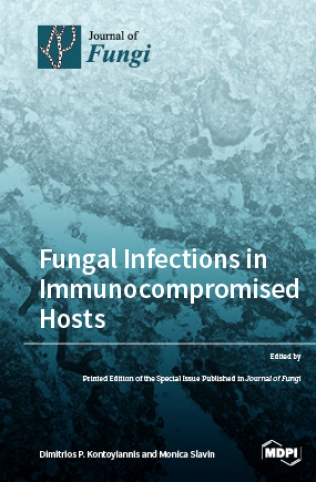Extended Use of Topical Efinaconazole Remains Safe and Can Provide Continuing Benefits for Dermatophyte Toenail Onychomycosis
IF 4.2
2区 生物学
Q2 MICROBIOLOGY
引用次数: 0
Abstract
Introduction: Efinaconazole 10% topical solution labeling for onychomycosis describes phase III trials of 12 months of treatment; the slow growth of onychomycotic nails suggests a longer treatment period may increase efficacy. We present here the first evaluation of extended use of efinaconazole 10% topical solution for up to 24 months. Materials and Methods: Enrolled patients (n = 101) had one target great toenail with mild to moderate distal lateral subungual onychomycosis and applied efinaconazole 10% topical solution to all affected toenails once daily for 18 months (EFN18) or 24 months (EFN24). Efficacy and safety were evaluated at each visit by visual review and mycology sampling. Results: Regarding the target toenail for patients treated for 24 months (EFN24), mycological cure (negative microscopy and culture) was 66.0% at Month 12, increasing to 71.7% at Month 24; effective cure (mycological cure and ≤10% affected nail) was 13.2% at Month 12, rising to 22.6% at Month 24. Mild to moderate application site reactions (symptoms of erythema/scaling) were the only efinaconazole-related reactions, in eight patients (7.9%). No systemic efinaconazole events or drug interactions were found. Patients aged 70 years or more had similar efficacy to younger patients at all time periods and did not show any increased treatment risks. Thinner nails exhibited better clearance versus thicker nails. A higher proportion of patients with Trichophyton mentagrophytes complex infection experienced application site reactions (35.7%), and a higher effective cure was found at Month 24 versus T. rubrum patients. Conclusion: There is a trend of increasing mycological cure and effective cure beyond Month 12 to Month 24, without an increased safety risk. The enrolled population in this trial was significantly older than in the phase III trials, with a greater degree of onychomycosis severity; however, increased age did not appear to reduce the chance of efficacy to Month 24 in this study. Our data suggest that lack of ability to clear nail dystrophy remains a significant problem for patients, rather than any lack of efinaconazole action over long-term treatment periods.延长局部使用依芬康唑的疗程仍然安全,并能为皮癣菌性趾甲甲癣带来持续疗效
简介:针对甲癣的 10%依芬康唑外用溶液在 III 期试验中的疗程为 12 个月;由于甲癣指甲生长缓慢,因此延长疗程可能会提高疗效。我们在此首次评估了延长使用 10%依芬康唑外用溶液长达 24 个月的情况。材料与方法:入组患者(n = 101)有一个目标大趾甲,患有轻度至中度远端外侧甲下真菌病,在所有受影响的趾甲上使用 10%的依芬康唑局部溶液,每天一次,持续 18 个月(EFN18)或 24 个月(EFN24)。每次就诊时,通过目测和真菌学取样评估疗效和安全性。结果对于治疗 24 个月的患者的目标趾甲(EFN24),真菌学治愈率(显微镜检查和培养阴性)在第 12 个月时为 66.0%,在第 24 个月时增至 71.7%;有效治愈率(真菌学治愈且受影响趾甲≤10%)在第 12 个月时为 13.2%,在第 24 个月时增至 22.6%。轻度至中度的涂抹部位反应(红斑/脱屑症状)是唯一与依芬康唑相关的反应,有 8 名患者(7.9%)出现这种反应。没有发现全身性的依芬康唑事件或药物相互作用。70岁或以上的患者在所有时间段的疗效都与年轻患者相似,并且没有显示出任何治疗风险的增加。较薄的指甲与较厚的指甲相比,清除率更高。有较高比例的复合毛癣菌感染患者出现了用药部位反应(35.7%),与红癣菌患者相比,第24个月的有效治愈率更高。结论从第 12 个月到第 24 个月,真菌学治愈率和有效治愈率呈上升趋势,但安全风险并未增加。与 III 期试验相比,本试验的入组人群年龄明显偏大,而且甲癣严重程度更高;不过,在本研究中,年龄的增加似乎并没有降低第 24 个月的疗效。我们的数据表明,缺乏清除甲营养不良的能力仍然是患者面临的一个重要问题,而不是在长期治疗期间缺乏依芬康唑的作用。
本文章由计算机程序翻译,如有差异,请以英文原文为准。
求助全文
约1分钟内获得全文
求助全文
来源期刊

Journal of Fungi
Medicine-Microbiology (medical)
CiteScore
6.70
自引率
14.90%
发文量
1151
审稿时长
11 weeks
期刊介绍:
Journal of Fungi (ISSN 2309-608X) is an international, peer-reviewed scientific open access journal that provides an advanced forum for studies related to pathogenic fungi, fungal biology, and all other aspects of fungal research. The journal publishes reviews, regular research papers, and communications in quarterly issues. Our aim is to encourage scientists to publish their experimental and theoretical results in as much detail as possible. Therefore, there is no restriction on paper length. Full experimental details must be provided so that the results can be reproduced.
 求助内容:
求助内容: 应助结果提醒方式:
应助结果提醒方式:


